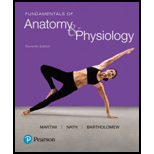
Fundamentals of Anatomy & Physiology (11th Edition)
11th Edition
ISBN: 9780134396026
Author: Frederic H. Martini, Judi L. Nath, Edwin F. Bartholomew
Publisher: PEARSON
expand_more
expand_more
format_list_bulleted
Textbook Question
Chapter 7, Problem 4RQ
The boundaries between skull bones are immovable joints called (a) foramina, (b) fontanelles, (c) lacunae, (d) sutures.
Expert Solution & Answer
Want to see the full answer?
Check out a sample textbook solution
Students have asked these similar questions
The flat bones of the skull develop from (a) areolar tissue, (b) hyaline cartilage, (c) mesenchyme membranes, (d) compact bone.
The axial skeleton consists of the bones of the: (a) pectoral and pelvic girdles.(b) skull, rib cage, and vertebral column. (c) arm, legs, hand, and feet. (d) limbs, pectoral girdle, and pelvic girdle.
The lateral malleolus is the (a) proximal portion of the fibula, (b) distal portion of the tibia, (c) distal portion of the fibula, (d) proximal portion of the ulna, (e) bone in the middle ear cavity.
Chapter 7 Solutions
Fundamentals of Anatomy & Physiology (11th Edition)
Ch. 7 - Identify the bones of the axial skeleton.Ch. 7 - Prob. 2CPCh. 7 - Prob. 3CPCh. 7 - Toms suffers a hit to the skull that fractures the...Ch. 7 - Prob. 5CPCh. 7 - Prob. 6CPCh. 7 - Prob. 7CPCh. 7 - Prob. 8CPCh. 7 - Name the foramina found in the ethmoid bone.Ch. 7 - Prob. 10CP
Ch. 7 - Prob. 11CPCh. 7 - Prob. 12CPCh. 7 - Prob. 13CPCh. 7 - Prob. 14CPCh. 7 - Prob. 15CPCh. 7 - Prob. 16CPCh. 7 - Prob. 17CPCh. 7 - Joe suffered a hairline fracture (fracture without...Ch. 7 - Prob. 19CPCh. 7 - Prob. 20CPCh. 7 - Describe false ribs.Ch. 7 - Prob. 22CPCh. 7 - Prob. 23CPCh. 7 - Prob. 1RQCh. 7 - Prob. 2RQCh. 7 - Prob. 3RQCh. 7 - The boundaries between skull bones are immovable...Ch. 7 - The joint between the frontal and parietal bones...Ch. 7 - Prob. 6RQCh. 7 - Prob. 7RQCh. 7 - Cervical vertebrae can usually be distinguished...Ch. 7 - The lateral walls of the vertebral foramen are...Ch. 7 - Prob. 10RQCh. 7 - Which eight bones make up the cranium?Ch. 7 - Prob. 12RQCh. 7 - Prob. 13RQCh. 7 - In addition to the spinal curves, what skeletal...Ch. 7 - Prob. 15RQCh. 7 - Prob. 16RQCh. 7 - Describe how movement of the ribs functions in...Ch. 7 - Prob. 18RQCh. 7 - The atlas (C1) can be distinguished from the other...Ch. 7 - Prob. 20RQCh. 7 - Prob. 21RQCh. 7 - Prob. 22RQCh. 7 - Prob. 23RQCh. 7 - Prob. 24RQCh. 7 - Prob. 25RQCh. 7 - Mary is in her last month of pregnancy and is...Ch. 7 - What are the seven bones that make up each orbital...Ch. 7 - Prob. 2CC
Knowledge Booster
Learn more about
Need a deep-dive on the concept behind this application? Look no further. Learn more about this topic, biology and related others by exploring similar questions and additional content below.Similar questions
- The major function of intervertebral discs is to a) Absorb shock b) String the vertebrae together c) Prevent injuries d) Prevent hypertensionarrow_forwardThe appendicular skeleton consists of the bones of the, (a) pectoral and pelvic girdles. (b) skull, rib cage, and vertebral column. (c) arm, legs, hand, and feet (d) limbs, pectoral girdles, and pelvic girdle.arrow_forwardAbduction and adduction always refer to movements of the: (a) axial skeleton. (b) appendicular skeleton. (c) skull. (d) vertebral column.arrow_forward
- The appendicular skeleton consists of the bones of the (a) pectoral and pelvic girdles. (b) skull, thorax, and vertebral column. (c) arm, legs, hand, and feet. (d) limbs, pectoral girdles, and pelvic girdle.arrow_forwardThe greater and lesser tubercles are located on the (a) humerus, (b) hip bone, (c) femur, (d) ankle, (e) tibia.arrow_forward(a) What is the function of intervertebral discs? (b) Distinguish the anulus fibrosus from the nucleus pulposus of a disc. (c) Which part herniates in the condition called prolapsed disc?arrow_forward
- Match the bones in column B with their description in column A.arrow_forwardThe bone that is not involved in the formation of the hip bones is the (a) ischium, (b) ilium, (c) pubis, (d) sacrum.arrow_forwardOf the following bones, which one is unpaired? (a) vomer (b) maxilla (c) palatine (d) nasalarrow_forward
arrow_back_ios
SEE MORE QUESTIONS
arrow_forward_ios
Recommended textbooks for you
 Anatomy & PhysiologyBiologyISBN:9781938168130Author:Kelly A. Young, James A. Wise, Peter DeSaix, Dean H. Kruse, Brandon Poe, Eddie Johnson, Jody E. Johnson, Oksana Korol, J. Gordon Betts, Mark WomblePublisher:OpenStax College
Anatomy & PhysiologyBiologyISBN:9781938168130Author:Kelly A. Young, James A. Wise, Peter DeSaix, Dean H. Kruse, Brandon Poe, Eddie Johnson, Jody E. Johnson, Oksana Korol, J. Gordon Betts, Mark WomblePublisher:OpenStax College

Anatomy & Physiology
Biology
ISBN:9781938168130
Author:Kelly A. Young, James A. Wise, Peter DeSaix, Dean H. Kruse, Brandon Poe, Eddie Johnson, Jody E. Johnson, Oksana Korol, J. Gordon Betts, Mark Womble
Publisher:OpenStax College
The Skeletal System; Author: Professor Dave Explains;https://www.youtube.com/watch?v=f-FF7Qigd3U;License: Standard YouTube License, CC-BY